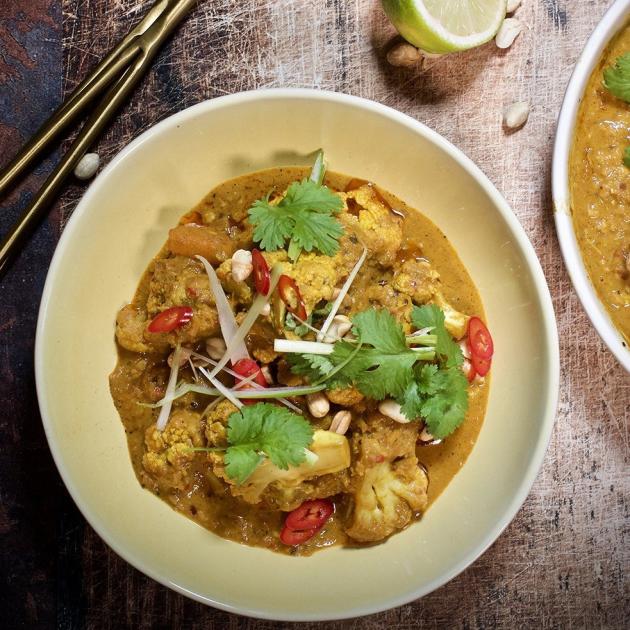

As you know I love food and I particularly love to celebrate the mighty vegetable. Winter time is no different as we are blessed with robust greens, hearty root vegetables and nourishing brassicas.
It is also getting harder and harder to keep on top of the food budget. Spiralling costs have meant we have had to make changes and for me it has impacted on what we eat in our household.
However this has turned out to be a good thing and has given us all a refreshing look at our diet and how we can not only save money but how we can improve our health.
I have taken some key, everyday ingredients and added my favourite sauce or ingredients to produce dishes I once would have only made with meat or meat by-products.
Using vegetables to become the star of your meals is rewarding in so many ways.
Have a look at some of your favourite dishes and see if you too can make changes not only to save a few dollars but to improve your health and add the endless variety of amazing vegetables to your diet.
Enjoy.

Kiwi (vege) burger
This burger is an absolute winner. Whether you are plant-based or not, this vege-based patty is a combination of delicious mushrooms, beans and beetroot.
When added to your burger with all your favourite toppings your taste buds will be blown away!
SERVES 4
Preparation time: 20 minutes
Cooking time: 30 minutes
Skill: easy
4 burger buns
Pattie
1 can kidney, adzuki or black beans, drained
250g mushrooms
1 shallot, roughly chopped
150g bread, roughly chopped or breadcrumbs
½ tsp salt
Freshly ground black pepper
2 tsp soy sauce
Few splashes Worcestershire sauce
1 medium (160g) beetroot, peeled and coarsely grated
Fillings
Mustard
Tomato sauce
4 Iceberg lettuce leaves
4-8 slices pickled beetroot
2-3 gherkins, sliced thinly
4 slices cheese
2 tomatoes, sliced thickly
Onion, thinly sliced
Method
Preheat oven 200°C.
Place the mushrooms and shallot in the bowl of the food processor and blend lightly.
Add the drained beans and season with salt and pepper, pulse to combine. Do not over-blend as it will go mushy.
Add the beetroot, soy and Worcestershire and mix together, mould into 4 even-sized patties.
Lightly grease an oven tray with oil and place the patties on to the tray.
Roast for 10 minutes, turn over and continue cooking for another 10 minutes.
Meanwhile, gather the ingredients to go with the burger.
Prepare the buns, lightly toast or warm.
Have all your fillings prepared and ready to load on to your burger.
Once the burger patties have cooked for 20 minutes, lay over the sliced cheese and return to the oven. Change to grill setting and quickly grill until the cheese is melted and bubbly.
Place on to your prepared burger bun, layer with your desired fillings, place the top on and enjoy.

Satay cauliflower
It is hard to pass up a good satay sauce and this dish is using cauliflower instead of the more traditional chicken and it works so well.
The cauliflower is marinated then seared to add another level of flavour. It is then finished in the lightly spiced peanut satay sauce.
SERVES 4
Preparation time: 30 minutes
Cooking time: 40 minutes
Skill: easy
Satay seasoning
1½ tsp ground cumin
1½ tsp ground coriander
1½ tsp turmeric
½-1 tsp chilli powder
1 tsp paprika
3 tsp curry powder
1¼ tsp salt
2 tsp sugar
750g cauliflower, cut into large florets
2 (400g) sweet potatoes, large cubes
Satay sauce
2 Tbsp oil
1-3 red chillies (depending on how hot you want it)
1 onion, diced
4 garlic cloves, crushed
2 lemongrass stalks
1 cup peanuts, roasted
500ml vegetable stock
2 tsp kecap manis
3 tsp soy sauce
1 400ml can coconut milk
3 Tbsp peanut butter
2 limes, juice and zest
Coriander sprigs for garnish
Method
Begin by adding all the ingredients for the seasoning into a bowl and stir well to combine.
Sprinkle over 3½ tablespoons of the seasoning mix over the cauliflower florets and mix well to coat. Set aside for at least an hour if possible to allow the spices to seep into the cauliflower.
Over a medium heat, add the oil to a large fry pan.
Add the seasoned cauliflower in 2 batches if need be as you do not want to overload the fry pan. Cook the cauliflower quickly as you want to retain the crispness. Remove from the pan and set aside
To make the satay sauce.
Using the same pan add the onion, garlic, chilli, lemon grass and cook for 3-4 minutes over a moderate heat.
Add the mixture to a blender along with 1 cup of vegetable stock and 1 cup of peanuts and blend until almost smooth.
Pour this mixture back into the pan and add the remaining stock, peanut butter, coconut milk, kecap manis and soy sauce. Bring the mixture back to the boil, reduce the temperature to a gentle simmer, add the cauliflower and sweet potato,
Simmer until the vegetables are tender.
Finish with a sprinkle of roasted peanuts, coriander and fresh lime.
Serve with brown fluffy rice.

Crispy Korean-style fried gnocchi
There cannot be many of us out there who don’t enjoy the sweet, sticky spice of Korean fried chicken.
I adore it and for those more relaxed weekend vibe dinners this one is fantastic.
I have even cheated with this one and bought ready-made gnocchi and dressed it up with this delicious sauce, scatter over some spring onions and more sesame seeds and you have a delicious dinner in 30 minutes.
SERVES 4
Preparation time: 15 minutes
Cooking time: 30 minutes
Skill: easy
500g potato gnocchi
2 Tbsp cornflour
2 Tbsp neutral oil
Sauce
2 Tbsp gochujang paste
2 Tbsp soy sauce
1 Tbsp brown sugar
3-4 Tbsp maple syrup or agave
2 Tbsp tomato paste
2 Tbsp sesame seeds
30ml water
Spring onions, sliced thinly to garnish
Method
Bring a large pot of salted water to the boil.
Meanwhile to make the sauce, combine all the ingredients together in a medium saucepan, whisk the ingredients together.
Bring to the boil then reduce to a simmer. Cook until the sauce has reduced and thickened (10 minutes).
Once the water has come to the boil, add the gnocchi and give it a stir to separate the gnocchi.
Cook the gnocchi as directed on the packet. You will notice the gnocchi rising to the surface, once all gnocchi has done this, drain immediately and refresh under cold water.
Toss the drained gnocchi in the cornflour.
Add the oil to a large fry pan, when hot add the gnocchi (may need to do this stage in batches). Cook until golden and crispy.
When all the gnocchi has been cooked, toss it in the sauce so it is well coated.
Serve with the spring onions.

Aquafaba macarons
Well this was a revelation as I had never tried to make macarons egg-free before. Actually I didn’t even realise it was possibility.
I simply used the aquafaba from a tin of chickpeas, to substitute the egg whites and the rest of the process was the same.
They turned out incredible and it was a delight to be able to share them with friends and family who would normally not be able to eat them for dietary reasons.
MAKES 20 SHELLS
Preparation time: 30 minutes
Cooking time: 18 minutes
Skill: difficult
250g aquafaba
¼ tsp cream of tartar
100g caster sugar
100g icing sugar
100g ground almonds
Colourings
Icing
80g dairy free spread
200g icing sugar
½ tsp vanilla essence
Plant-based milk
Method
Begin by reducing the aquafaba until you reach 125g of liquid. You need to be very precise with measurements. Once you have the correct weight, cool the aquafaba in the refrigerator until completely cold.
Preheat the oven 150°C/130°C fan-forced.
Whisk the aquafaba.
Weigh out 100g of your reduced aquafaba and place it in a scrupulously clean bowl of your electric mixer along with the cream of tartar. Whisk on high speed until the mixture becomes thick and goes pale in colour.
With the mixer still going, start adding your caster sugar a little at a time. Keep whisking until the mixture becomes white and glossy and forms stiff peaks, just as you would for meringues. This takes a bit longer than it would with egg whites, keep whisking!
In a separate bowl, sieve the icing sugar and ground almonds, pushing any lumps through.
Fold half of the dry ingredients into the meringue mixture.
Add the remaining dry ingredients and fold through, do not over mix or the mixture can become a little runny.
If you are colouring the mixture, divide the base into small bowls and add the colouring, mix through gently.
Line two baking trays with baking paper or a silicon mat.
Place the mixture into a piping bag, using a plain medium-sized nozzle. If using different colours you will need to repeat this process with each colour.
Pipe 3cm rounds allowing a little space between each one (If you find this difficult I use a milk bottle lid and trace the circles on to the paper).
Slam the tray(s) on a work surface to get rid of any air bubbles, then let them sit at room temperature for 20-30 minutes, or until you can touch them without getting any mixture on your fingers.
Bake one tray at a time, it took 18 minutes for me to cook them at home but ovens can vary. To test if cooked, gently touch the top of a macaron and if it feels a little wobbly continue cooking.
Remove and cool.
When cool, carefully remove off the paper and match them up so they are the same size.
To make the filling, whisk the dairy-free spread until creamy, add the icing sugar and continue beating until light, creamy and lump free.
You can add flavourings to the icing which can be nice to add a more individual note to the different colours.
Pipe the icing on to one of the macarons and gently sandwich on the top. Continue until all the macarons are complete.
Store the macarons in an airtight container in the fridge for up to 3-4 days.
Macarons can be frozen for up to 2 months.
Seasons - By Alison Lambert - Available for purchase now!

The Otago Daily Times and Alison have collaborated to bring you her first cookbook – Seasons.
This book is the ultimate year-round cookbook. Seasons is filled with versatile recipes designed to inspire creativity in the kitchen, offering plenty of ideas for delicious accompaniments and standout dishes that highlight the best of what each season has to offer.
$49.99 each. Purchase here.
$44.99 for ODT subscribers. Get your discount code here.













